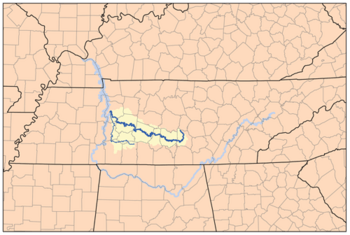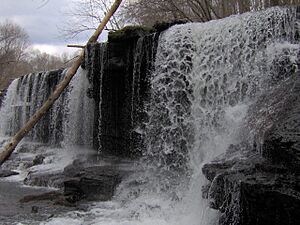Duck River (Tennessee) facts for kids
Quick facts for kids Duck River |
|
|---|---|

|
|
| Physical characteristics | |
| Length | 284 miles (457 km) |
The Duck River is a special river in Tennessee. It is about 284 miles long. This makes it the longest river that stays completely inside Tennessee. Most of the river flows freely, without dams. It is home to many different kinds of life. You can find over 50 types of freshwater mussels here. There are also 151 different kinds of fish. This makes the Duck River the most biologically diverse river in North America.
Contents
Where the Duck River Begins
The Duck River helps drain a large part of Middle Tennessee. It starts in the hills of an area called the "Barrens." This area gets a lot of rain. Even so, early settlers found it without many trees. Scientists have different ideas about why this was.
Towns Along the River
The river flows through several towns. It enters Manchester. Here, it meets a smaller river called the Little Duck River. This meeting point is at Old Stone Fort State Park. The park is named after an old structure built by Native American people. This structure is almost 2,000 years old.
Other important towns along the Duck River include Shelbyville, Columbia, and Centerville.
Dams and Reservoirs
South of Shelbyville, the Duck River is held back by the Normandy Dam. This dam was built in the early 1970s. It was a project by the Tennessee Valley Authority. The main reasons for building it were to control floods and for recreation. Unlike some other dams, Normandy Dam does not make electricity. It was named after the nearby small town of Normandy.
The water held back by the dam forms a reservoir. This lake covers over 5,000 acres. Before the dam, this land was used for farming. Further downstream, Shelbyville is protected from floods. Levees and floodgates help keep the river from overflowing into the town. There is also an older dam near downtown Shelbyville. It was built long ago to make electricity. This was before the Tennessee Valley Authority was created.
The Unfinished Columbia Dam
In Maury County, you can find the Yanahli Wildlife Preserve. This land was once planned for another dam and reservoir. This project was called the Columbia Dam. However, it was never finished. An endangered species of mussel was found in this part of the Duck River. Also, studies showed the dam would cost too much money. After many years of disagreements, the dam was taken apart. A lot of public money was lost on this project.
Another old dam is located downstream from where the Columbia Dam was planned. People tried to fix this old dam to make electricity again. But it has not worked out. The Duck River often floods parts of Columbia. This happens especially in the neighborhoods near downtown.
The River's Journey to the Tennessee River
Between Columbia and Centerville, the Duck River flows through a hilly area. Several smaller rivers join it here. One important one is the Piney River. Downtown Centerville is built high above the river.
Below Centerville, the Duck River flows through a quiet, rural area again. Its biggest branch, the Buffalo River, joins the Duck River in southern Humphreys County. This is just a few miles before the Duck River flows into the Tennessee River. The area where the Duck River meets the Tennessee River is part of the Tennessee National Wildlife Refuge.


